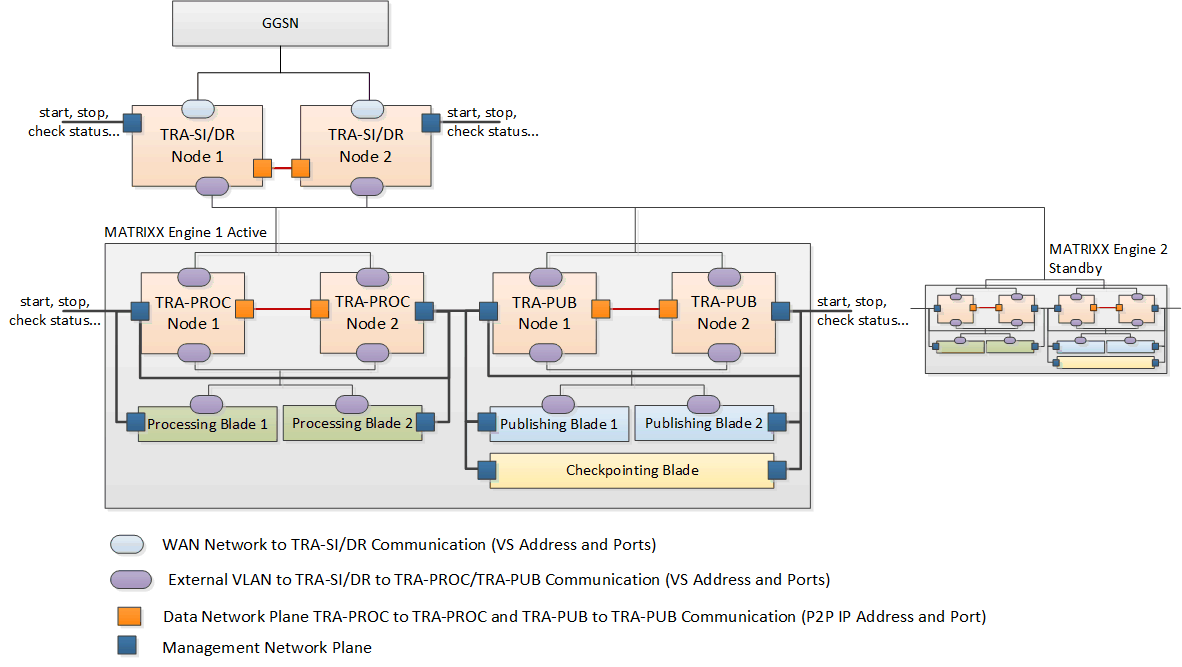MATRIXX Traffic Routing Agent
The MATRIXX Traffic Routing Agents (TRAs) load balance and route traffic among the MATRIXX components and provide high availability (HA) protection. Depending on their function, the TRAs can also load balance traffic and serve as a Diameter peer. In addition to HA protection, TRAs also provide a single virtual IP address point of access for BSS systems and network nodes to send network traffic to.
Depending on how you deploy and configure TRAs, they:
- Serve as a single point of entry to TCP network traffic coming into MATRIXX Engine for processing.
- Provide HA protection for the single point of entry. Because they are always deployed in HA pairs, if one TRA node fails, its HA peer takes over its functions.
- Route traffic from network nodes to the appropriate MATRIXX Engine, based on information in the message.
- Load balance the traffic from network nodes among MATRIXX Engine processing servers.
- Provide HA protection for MATRIXX Engine while ensuring that messages are always processed by an active engine.
- Send response messages back to the network or to the client applications as necessary.
- Accept either IPv4 or IPv6 traffic.
MATRIXX supports these TRA functions:
- TRA-(SI/DR) — Routes traffic to a MATRIXX Engine sub-domain.
In a MATRIXX environment with multiple customer sub-domains, the TRA-RT identifies and routes Diameter, CAP, and SubMan network traffic requests to the correct customer domain for processing. The TRA-RT obtains the necessary routing information from the routing database (Route Cache) that runs on its server and can handle MDC and Diameter cache-misses. The Route Cache and its associated processes are included in the TRA RPM.
If your MATRIXX implementation only uses one customer sub-domain, you do not need a TRA-RT or Route Cache.
- TRA-SI — (Site Independence - Application Layer Protocol) Routes
traffic to a MATRIXX Engine. Use this or a TRA-DR.
The TRA-SI routes TCP or UDP traffic to the active sub-domain. If your MATRIXX implementation includes multiple customer sub-domains, you typically install and configure one TRA with the combined roles of af TRA-RT-(SI/DR).
- TRA-DR — (Disaster Recovery - Protocol Layer 4) Includes the same functionality as a TRA-SI and can also act as a Diameter peer to answer Capabilities-Exchange-Request messages. Use this or TRA-SI. For more information about using TRA disaster recovery features, see the discussion about MATRIXX Traffic Routing DR features.
- TRA-PROC and TRA-PROC with RCP — (Load Balancer for processing servers) Routes traffic among MATRIXX Engine processing servers.
The TRA-PROC load balances traffic between the processing servers of the engine it serves. The TRA-PROC is usually collocated on two of the processing servers on a MATRIXX Engine. Each engine (active and standby) is assigned its own TRA-PROC cluster. The TRA-PROC with RCP load balances traffic among processing servers if sub-domain routing is used.
- TRA-PUB — (Traffic router for publishing servers) Routes event streaming traffic and internal MDC traffic to the active MATRIXX Engine publishing blade. The TRA-PUB HA pair is collocated on MATRIXX Engine; one runs on each of the publishing servers.
Figure 1 shows the various TRA functions and their management and data network connections with other components of MATRIXX.

For information, see the discussion about configuring Traffic Routing Agents in the MATRIXX environment in MATRIXX Configuration.
